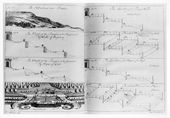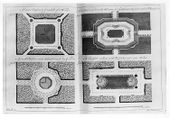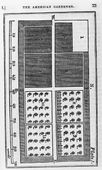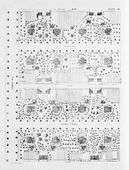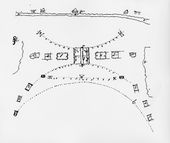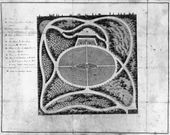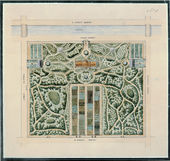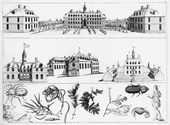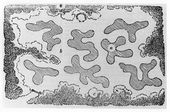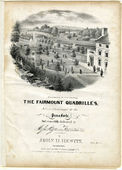Difference between revisions of "Plot/Plat"
C-tompkins (talk | contribs) |
C-tompkins (talk | contribs) |
||
| Line 204: | Line 204: | ||
Image:0034.jpg|[[Robert Mills]], Alternative plan for the grounds of the National Institution, 1841. | Image:0034.jpg|[[Robert Mills]], Alternative plan for the grounds of the National Institution, 1841. | ||
| − | Image:1150.jpg|c. 1847 | + | Image:1150.jpg|[[Joseph C. Wells]], Roseland Cottage, c. 1847. |
Image:0996.jpg|Anonymous, “A Small Arabesque Flower Garden,” in [[A. J. Downing]], ed., ''Horticulturist'' 2, no. 11 (May 1848): 504. | Image:0996.jpg|Anonymous, “A Small Arabesque Flower Garden,” in [[A. J. Downing]], ed., ''Horticulturist'' 2, no. 11 (May 1848): 504. | ||
Revision as of 17:08, January 21, 2015
(Grass-plat, Grass-plot)
Discussion
Plot, according to many lexicographers, was synonymous with plat. Noah Webster, for example, in 1828, used “plat” (“or small extent of ground”) to define “plot” and further indicated that the latter term held at least four distinct meanings. The first two definitions of the term—a small extent of ground or garden and an executed design of plant material—are well documented in textual and visual materials relating to the designed landscape in America. The third and fourth definitions, relating to survey plans, are less pertinent to landscape-design vocabulary and, therefore, appear less frequently in the material of our study. Even so, these latter references were still used occasionally, as indicated by Charles Willson Peale’s use of the term in 1810 to describe the plan that he had drawn of his property and by William H. Ranlett’s 1849 designation of a plan as “a protracted ground plot.”
In its first two definitions, plot referred to property divisions, which ranged in size from quarters of a garden to house lots or even larger portions of property. Used to describe a particular area of ground, the term “plot” relates closely to “plat” and, in general usage, the terms were nearly interchangeable. Timothy Dwight, in 1796, used “plat” to describe the combined lots of a New England town, while Ranlett, in 1849, used “plot” to describe the ideal layout of a village subdivided into lots [Fig. 1]. Plat, however, often had the added connotation of topographic flatness, a characteristic not necessarily associated with plot.
When used to indicate house lots, plots were typically rectangular in form, as indicated by William Strachey (1612) and Ranlett. But plots could take on a variety of forms in correspondence with their use as orchards, vineyards, pastures, gardens, walks, parks, or cornfields. James Silk Buckingham, for example, described in 1842 a triangular plot of land created by intersecting roads. In James E. Teschemacher’s 1835 report of a garden building, he describes a crescent-shaped plot, which he instructed should be kept closely mown and planted with ornamental trees.
Plots regarded as part of the cultivated, designed landscape could be planted with a variety of vegetation depending on their use. Grass was most commonly used, and a plot most frequently referred to a grassy space located near a house, particularly in the late eighteenth and first half of the nineteenth centuries, when the practice of surrounding a house with lawn became more prevalent (see Lawn). The wide variety of terms to describe the expanse of turf either in front of or behind a house is exemplified by Mount Vernon, where the grassy area in front of the house was described variously as plot, plat, lawn, and bowling green (see Bowling green).
Ornamentation of grass plots changed during this same period. Early descriptions of grass plots suggest a broad turfed area, perhaps bordered by ornamental shrubs and trees. Flower beds do not appear in these descriptions and, in fact, in 1803 Elizabeth Drinker recounted removing flowers from the garden in order to convert the space into grass plots with trees. By the 1820s and 1830s, descriptions of grass plots make it clear that they contained flower beds, as well as ornamental trees and shrubs. Marking the boundaries of plots was often a concern and was accomplished through the use of both organic and inorganic materials. In 1629 early English settler John Smith described setting the limits of plots with rows of trees, a technique that provided shade and a wind-break, and thus sheltered the plots’ contents. The grass plot at the Charles Norris House in Philadelphia, as described in 1867, was bordered by “roses intermixed with currant bushes.”[1] William Tennent’s 1764 prospect of Nassau Hall at the College of New Jersey (now Princeton University) depicts a grass plot, in front of the hall, demarcated by a fence [Fig. 2]. Bricks were used to enclose the plots at the State House in Philadelphia, according to William Dickinson Martin (1809). Such boundaries not only protected the space from destruction by animals, but also designated it as a special segment of the ground set apart for ornamental and utilitarian purposes.
Webster also used the term “grass-plat” to define an esplanade in a gardening context. Samuel Deane (1790) described plat as a topographically level partition of a garden. Thomas Green Fessenden (1828) and Joseph Breck (1851) continued this connotation of flatness and used the term to describe the ideal flat setting for a garden. William Cobbett (1819) equated the term with “quarter,” explaining that both terms referred to small subdivisions of a garden (see Quarter). He added that plat was the more universally understood appellation of the feature, whereas quarter was associated with specifically British usage. Plat could also refer to a portion of a map or plan that was subdivided for settlement, or to the actual subdivided lots indicated on the plan.[2] In general, references to subdivisions (or sections of ground) constitute the most common usage of this term [Fig. 3] and are the focus of the most frequently cited examples discussed here.
The grass plat was an essential component of garden design from at least the mid-eighteenth to the mid-nineteenth centuries, and the form could vary in size and shape. At William Byrd III’s Westover on the James River, in 1783, Thomas Lee Shippen described a 300-foot-by-100-yard expanse between the house and the river as a plat, and C. M. Hovey, in 1841, referred to a circular plat 100 feet in diameter at James Dundas’s residence in Philadelphia. The plat of Hermitage, Andrew Jackson’s estate in Nashville, was described as guitar shaped.
Situated adjacent to a residence, a grass plat, like a lawn or grass plot, functioned as a frame or setting [Fig. 4]. Perhaps because of this association with the residence, in particular, plat came to be regarded as analogous to yard (see Yard). An article in the Horticultural Register (1837), for example, castigated the American trend of clearing away all vegetation around the house, leaving an unornamented yard or, slightly better, “a handsome grass plat.” Walter Elder’s 1849 recommendation that a grass plat near a house could be used as a bleaching area for cloth recalls the utilitarian associations of yards.
Grass plats were not always attached to houses. Large stretches of turf, perhaps edged with walks or roads, were also incorporated into public gardens and designed landscapes, as in the representation of Gray’s Garden and Fairmount Waterworks in Philadelphia [Fig. 5]. Grass plats could also be decorated with flowers, statues, or seats and they could be bounded by vegetation, walks, or fences. Plat borders might be less obviously marked, for example, if the landscape gardener or designer utilized a ha-ha (or sunk fence), as recommended by Teschemacher in 1835. Because of the variety of ornamentation that could be accommodated by the plat, the feature bridged different styles of garden design that flourished during the eighteenth and nineteenth centuries.
-- Anne L. Helmreich
Texts
Usage
- Strachey, William, 1612, describing Native American settlements in Virginia (quoted in Wright and Freund 1967: 79) [3]
- “About their howses, they haue [sic] commonly square plotts of cleered grownd, which serve them for gardeins, some 100. some 200. foote square, wherein they sowe their Tobacco, pumpeons, and a fruit like vnto a musk-million; but lesse and worse, which they call Macocks.”
- Smith, John, 1629, describing the Charles River in Massachusetts (quoted in Miller and Johnson 1963: 2:399) [4]
- “in the maine you may shape your Orchards, Vineyards, Pastures, Gardens, Walkes, Parkes, and Corne fields out of the whole peece as you please into such plots, one adjoyning to another, leaving every of them invironed with two, three, foure, or six, or so many rowes of well growne trees as you will, ready growne to your hands, to defend them from ill weather.”
- Records of Plymouth Colony, 2 August 1653, describing Plymouth, Mass. (quoted in Lockwood 1931: 1:22) [5]
- “John Cooke Senior of Plymouth doth acknowledge that for 3 pounds he hath—sold—Thomas Lettice an house and garden plot on which the said house standeth, being scituate in Plymouth . . . next the house and garden plott in which Thomas Lettice now liveth; To have and to hold the said house and garden plott next adjoining unto the garden place or meerstead on which the said Thomas Lettice now liveth.”
- Pinckney, Eliza Lucas, 1743, describing Crowfield, plantation of William Middleton, vicinity of Charleston, S.C. (1972: 61) [6]
- “From the back door is a spacious walk a thousand foot long; each side of which nearest the house is a grass plat ennamiled in a Serpenting manner with flowers.”
- Fithian, Philip Vickers, 31 December 1773, describing Nomini Hall, Westmoreland County, Va. (1943: 58) [7]
- “Assoon [sic] as the Bell rang & I had dismissed the Children I took a walk in the Garden; When I had gone round two or three Platts Mrs Carter entered and walked towards me.”
- Carroll, Charles (of Annapolis), 1775, describing Carroll Garden, Annapolis, Md. (Maryland Historical Society, A. E. Carroll Papers)
- “Examine the Gardiner strictly as to. . . . Whether he is an expert at levelling, making grass plots & Bowling Greens, Slopes, & turfing them well, &c.”
- Shippen, Thomas Lee, 30 December 1783, describing Westover, seat of William Byrd III, on the James River, Va. (1952: n.p.) [8]
- “Imagine then a room of 20 feet square . . . and commanding a view of a prettily falling grass plat variegated with pedestals of many different kinds, about 300 by 100 yards in extent an extensive prospect of James River and of all the Country and some Gentleman’s seats on the other side.”
- Washington, George, 1785, describing Mount Vernon, plantation of George Washington, Fairfax County, Va. (Jackson and Twohig, eds., 1978: 4:92, 97) [9]
- “[18 February] Also [planted] four Lime or Linden Trees, sent me by Govr. Clinton of New York. . . . These were planted in the Serpentine Roads to the door—the 3d. trees on each side next the Walls & the second trees on each side next the grass plat. . . .
- “[3 March] . . . Likewise took up the clump of Lilacs that stood at the Corner of the South Grass plat & transplanted them to the clusters in the Shrubberies & standards at the south Garden gate.”
- Cutler, Rev. Manasseh, 14 July 1787, describing Gray’s Tavern, Philadelphia, Pa. (1987: 1:274–75) [10]
- “Nothing appears from the house, or in passing the street, that would attract the attention of the most inquisitive traveler, unless it be a flight of steps cut out of the solid rock at the east end of the house, by which you ascend to a beautiful grass plat, shaded with a number of large trees, in the rear of the house. . . . We returned [from our walk] to the grass plat, from which we ascended several glaces by a serpentine gravel walk, and came to the Green-house.”
- Constantia [pseud.], 24 June 1790, “Description of Gray’s Gardens, Pennsylvania” (Massachusetts Magazine 3: 414)
- “Upon the grass plats, loose seats are thrown up and down, and tall trees of an umbrageous foliage form an ample shade.”
- Bartram, William, 1791, describing Indian town in Georgia (1928: 169) [11]
- “They plant but little here about the town; only a small garden plot at each habitation.”
- Dwight, Timothy, 1796, describing Boston, Mass. (1821: 1:493–94) [12]
- “There are several pretty streets in Boston. Among them, Franklin Place. . . . The middle of the street is a grass plat, surrounded by trees, and guarded by posts and chains. The name is derived from a monument of Dr. Franklin, who was a native of this town.”
- Dwight, Timothy, 1796, describing Hallowell, Maine (1821: 2:218) [12]
- “Hallowell is a very pretty town, built on an irregular, or rather steep, descent. This slope, though interrupted, is handsome, and furnishes more good building spots, than if it had been an uniform declivity, and at the same time equally steep. Then all the grounds would have descended too rapidly. Now they furnish a succession of level surfaces for gardens, house-plats, and court yards; and are thus very convenient, as well as sometimes very handsome.”
- Dwight, Timothy, 1796, describing New England (1821: 2:335) [12]
- “New England villages . . . are built in the following manner. . . .
- “The town-plat is originally distributed into lots, containing from two to ten acres.”
- Brooks, Joshua, 1799, describing Mount Vernon, plantation of George Washington, Fairfax County, Va. (quoted in Riley 1989: 18) [13]
- “At the back of the house is a covered staircase to the kitchen or cellar. Here many male and female negroes were at work digging and carrying away the ground to make a level grass plot with a gravel walk around it, at one end of which is an ice house.”
- Ogden, John Cosens, 1800, describing a girls school in Bethlehem, Pa. (p. 14) [14]
- “Since the applications to receive pupils from abroad, have become so frequent and numerous, a new building has been erected for their use, upon a similar model, with the sisters house. A small court yard, or grass plat, is between these buildings.”
- Drinker, Elizabeth, 4 November 1803, diary entry (Historical Society of Pennsylvania, Diaries of Elizabeth Drinker, typescript)
- “Sent a number of different sorts of flower roots to Downingtown, and gave many away to others—they were dug out of ye beds on ye south side of our Garden- as my husband intends making grass-plots and planting of trees on that side.”
- Martin, William Dickinson, 20 May 1809, describing the State House, Philadelphia, Pa. (Colonial Williamsburg Foundation; hereafter CWF)
- “The State House . . . is a large building on the south side of Chestnut Street. . . . Attached to the State House, is a large green occupying a whole square to Walnut Street. This is a neat place, ornamented with rows of Elms & Poplars: as also having handsome gravel walks, one of which extends thro’ the Centre with grass plots on each side. The whole is enclosed in high brick walls.”
- Peale, Charles Willson, 29 July 1810, describing the ground plot at Belfield, estate of Charles Willson Peale, Germantown, Pa. (Miller, Hart, and Ward, eds., 1991: 3:53) [15]
- “This ground plot is made by recollection, but I think it near anough [sic] the truth to give you a more precise Idea of the place & the other Sketches which I intend to annex to my letters.” [Fig. 6]
- Foster, Sir Augustus John, c. 1811, describing Princeton University, Princeton, N.J. (1954: 284) [16]
- “It consists of two large buildings of stone in one of which all the students reside and a room with a closet is assigned in it to every two individuals. . . . No garden or pleasure ground is attached to this house which is removed from the street by a grass plot.”
- Anonymous, 1820, describing Memphis, Tenn. (quoted in Schwaab 1973: 179) [17]
- “Three hundred and sixty-two lots are designated upon its present plat; and there is any quantity of elevated, level land adjoining, suited to the purpose of enlarging it at pleasure.”
- Kremer, Eliza Vierling, 1824–29, describing the pleasure grounds at Salem Academy, Salem, N.C. (quoted in Bynum 1979: 29) [18]
- “A large garden, some little distance from the Academy, was during the Summer Season, a place for recreation after school hours. Each room division having an appointed plot where they could plant and cultivate flowers, many with an innate love for such work would be busy with trowel in hand, striving to have her plot the most beautiful.”
- Coolidge, Ellen Wayles Randolph, 1825, describing the village gardens in Massachusetts (quoted in Lockwood 1931: 1:109) [19]
- “The villages themselves have an air of neatness and comfort which is delightful. The houses have no architectural pretensions, but they are pleasing to look at, for they are almost all painted white, with vines about the windows and doors, and grass plots in front decorated with flowers and shrubs; a neat paling separates each domain from its neighbor.”
- Committee of the Pennsylvania Horticultural Society, 1830, describing Lemon Hill, estate of Henry Pratt, Philadelphia, Pa. (quoted in Boyd 1929: 431) [20]
- “Undoubtedly this is the best kept garden in Pennsylvania, and when associated with the green and hot house department, may be pronounced unrivalled in the Union. The gravel walks, espaliers, plants, shrubs, mounds, and grass plats, are dressed periodically and minutely.”
- Breck, Joseph, 1 February 1836, “Gardens, Hothouses, &c., in the vicinity of Boston,” describing Bellmont Place, residence of John Perkins Cushing, Watertown, Mass. (Horticultural Register 2: 43–44)
- “The garden is a square, level plot, bounded on the north side by the conservatories. . . . On the east and west are high, substantial brick walls. . . . The southern wall is very ornamental and substantial, and so low that the whole area and houses may be seen at a single glance outside the wall.”
- Kemble, Fanny, 17 February 1839, describing her husband’s plantations on Butler Island, Ga. (1984: 195) [21]
- “This morning, Sunday, I peeped round its [the farmhouse] immediate neighborhood, and saw, to my inexpressible delight, within hail, some noble-looking evergreen oaks, and close to the house itself a tiny would-be garden, a plot of ground with one or two peach trees in full blossom, tufts of silver narcissus and jonquils, a quantity of violets and an exquisite myrtle bush; wherefore I said my prayers with especial gratitude.”
- Buckingham, James Silk, 1841, describing the state prison in Auburn, N.Y. (2:234) [22]
- “The edifice within this wall has a front of 300 feet, facing nearly to the east, in the centre of which is the keeper’s residence; and two wings of 240 feet each extend behind this dwelling to the westward. It is in these two wings that the cells for the prisoners are contained, and between them is a grassplat, with gravel walks.”
- Mills, Robert, 23? February 1841, in a letter to Joel R. Poinsett, describing his plans for the national Mall, Washington, D.C. (Scott, ed., 1990: n.p.)[23]
- “The Botanic garden is laid out in the centre fronting and opening to the south. On each side of this the grounds are laid out in serpentine walks and in picturesque divisions forming plats for grouping the various trees to be introduced and creating shady walks for those visiting the establishments."
- Hovey, C. M., November 1841, “Notes made during a Visit to New York, Philadelphia, Baltimore, &c.,” describing the residence of James Dundas, Philadelphia, Pa. (Magazine of Horticulture 7: 420)
- “The garden is laid out with a large circular grass plat in the centre, about a hundred feet in diameter, and back of this, against the wall in the rear, is the green-house.”
- Buckingham, James Silk, 1842, describing Red Sulphur Springs, Va. (CWF)
- “In the centre of the valley, is a triangular plot of grass, which has been enclosed with well-finished rails, painted white, and laid out in walks like a lawn, having also several large and fine trees, under which seats are placed for enjoying the shade.”
- Jones, Rev. C. C., 5 June 1851, in a letter to his wife, Mary Jones, describing Hermitage, estate of Andrew Jackson, Nashville, Tenn. ([1851] 1976: 175) [24]
- “An iron gate let us into the lawn immediately before the mansion; nor had we in our approach seen anything more than the top of a chimney or the glimpse of a wall or pillar; nor did we see anything now, so embosomed is it in trees, and so full of small cedars and shrubbery is the lawn. The road winds around an enclosed plat in shape resembling a guitar, shut in by low white posts connected by a small rope with one another. The grass in this lot was much grown, and we observed that the mower had commenced to smooth it off with his scythe.”
Citations
Images
Inscribed
Edward Penington (artist), William Fletcher Boogher (publisher),"A description of two lotts in the city of Philadelphia, the one belonging to the Proprietary, William Penn, the other to his daughter, Lætitia Penn, together with the streets & lotts bounding them. Drawn this 23d day of the 12th month 1698 by Edward Penington, Surv. Genll" [detail], 1882 [1698].
Michael van der Gucht, Illustration for chapter entitled: “Of different Terrasses and Stairs, with their most exact Proportions,” in A.-J. Dézallier d’Argenville, The Theory and Practice of Gardening (1712), pl. opp. p. 117.
Michael van der Gucht, “Four Designs for Cloisters,” in A.-J. Dézallier d’Argenville, The Theory and Practice of Gardening (1712), pl. 9
Charles Bulfinch, “Plan & Elevation of the Tontine Crescent, now erecting in Boston,” in Massachusetts Magazine (Feb. 1794): pl. opp. p. 67.
Charles Willson Peale, Ground plot of Belfield, 1810.
William Cobbett, “Plan for a Garden,” in The American Gardener (1819), p. 33, pl. 1.
Frances Palmer, "Ground Plot of Brier Cottage," in William H. Ranlett, The Architect (1849), vol 1, pl. 2.
Frances Palmer, Ground plot of Anglo-Italian Villa, New York, in William H. Ranlett, The Architect (1849), vol 1, pl. 8.
Frances Palmer, Ground plots for proposed houses near Clifton, Staten Island, in William H. Ranlett, The Architect (1849), vol 1, pl. 18.
Frances Palmer, Ground plot of a cottage, in William H. Ranlett, The Architect (1849), vol 1, pl. 23.
Frances Palmer, "A plot of village property 724 feet by 488," in William H. Ranlett, The Architect (1849), vol 1, pl. 48.
Associated
Thomas Lee Shippen, Plan of Westover, 1783.
Samuel Vaughan, Plan of the buildings and grounds of Mount Vernon, 1787.
Thomas Jefferson, Bird’s-eye view of the University of Virginia, c. 1820.
James E. Teschemacher, "A green-house constructed at the centre of a cottage," in Horticultural Register and Gardener's Magazine vol. 1 (May 1, 1835), opp. p. 157.
Robert Mills, "Plan of the Mall," Washington, D.C., 1841.
Robert Mills, Alternative plan for the grounds of the National Institution, 1841.
Joseph C. Wells, Roseland Cottage, c. 1847.
Anonymous, “A Small Arabesque Flower Garden,” in A. J. Downing, ed., Horticulturist 2, no. 11 (May 1848): 504.
Frances Palmer, Plan and section of Villa at Oswego, New York [detail], in William H. Ranlett, The Architect (1851), vol 2, pl. 12.
Attributed
William Tennent, “A North-West Prospect of Nassau Hall, with a Front View of the Presidents House in New-Jersey,” Princeton College, 1764.
Pierre Pharoux, Plan for Esperanza (Speranza), 1794-95.
John Henry Bufford, "Fairmount from the first Landing," sheet music cover for The Fairmount Quadrilles, 1836.
- 1462.jpg
1851
- 1463.jpg
1851
- 1401.jpg
???
Notes
- ↑ Deborah Logan, The Norris House (Philadelphia: The Fair-Hill Press, 1867), 8. view on Zotero
- ↑ For the use of this term in the context of American settlement patterns, see Hildegard Binder Johnson, “Towards a National Landscape,” in The Making of the American Landscape, ed. Michael P. Conzen (New York: Routledge, 1990), 127–45. view on Zotero
- ↑ Louis B. Wright, and Virginia Freund, eds., The Historie of Travell into Virginia Britania (1612) (Nendeln and Liechtenstein: Kraus, 1967) view on Zotero
- ↑ Perry Miller and Thomas H. Johnson, eds., The Puritans, 2 vols. (New York: Harper and Row, 1963) view on Zoter
- ↑ Alice B. Lockwood, ed., Gardens of Colony and State: Gardens and Gardeners of the American Colonies and of the Republic before 1840, 2 vols. (New York: Charles Scribner’s for the Garden Club of America, 1931) view on Zotero
- ↑ Eliza Lucas Pinckney, The Letterbook of Eliza Lucas Pinckney, 1739-1762, ed. by Elise Pinckney (Chapel Hill: University of North Carolina Press, 1972) view on Zotero
- ↑ Philip Vickers Fithian, Journal & Letters of Philip Vickers Fithian, 1773-1774: A Plantation Tutor of the Old Dominion, ed. by Hunter D. Farish (Williamsburg, Va.: Colonial Williamsburg, 1943) view on Zotero
- ↑ Thomas Lee Shippen, Westover Described in 1783: A Letter and Drawing Sent by Thomas Lee Shippen, Student of Law in Williamsburg, to His Parents in Philadelphia (Richmond, Va.: William Byrd Press, 1952) view on Zotero
- ↑ George Washington, The Diaries of George Washington, ed. by Donald Jackson and Dorothy Twohig, 6 vols. (Charlottesville: University Press of Virginia, 1979) view on Zotero
- ↑ William Parker Cutler, Life, Journals, and Correspondence of Rev. Manasseh Cutler, LL. D (Athens, Ohio: Ohio University Press, 1987) view on Zotero
- ↑ William Bartram, Travels through North and South Carolina, Georgia, East and West Florida, ed. by Mark Van Doren (New York: Dover, 1928) view on Zotero
- ↑ 12.0 12.1 12.2 Timothy Dwight, Travels in New England and New York, 4 vols. (New Haven, Conn.: Timothy Dwight, 1821-22) view on Zotero
- ↑ John P. Riley, The Icehouses and Their Operations at Mount Vernon (Mount Vernon, Va.: Mount Vernon Ladies’ Association, 1989) view on Zotero
- ↑ John C. Ogden, An Excursion into Bethlehem & Nazareth, in Pennsylvania, in the Year 1799 (Philadelphia: Charles Cist, 1800) view on Zotero
- ↑ Lillian B. Miller, and et al, eds., The Selected Papers of Charles Willson Peale and His Family: Charles Willson Peale: Artist in Revolutionary America, 1735-1791. Vol. 1; Charles Willson Peale, Artist as Museum Keeper, 1791-1810. Vol 2, Pts. 1-2; The Belfield Farm Years, 1810-1820. Vol. 3; The Autobiography of Charles Willson Peale. Vol. 5. (New Haven, Conn.: Yale University Press, 1983–2000) view on Zotero
- ↑ Sir Augustus John Foster, Jeffersonian America: Notes on the United States of America Collected in the Years 1805-1806-1807 and 1811-1812, ed. by Richard Beale Davis (San Marino, Calif.: Huntington Library, 1954) view on Zotero
- ↑ Eugene L. Schwaab and Jacqueline Bull, Travels in the Old South (Lexington: University Press of Kentucky, 1973) view on Zotero
- ↑ Flora Ann L. Bynum, Old Salem Garden Guide (Winston-Salem, N.C.: Old Salem, 1979) view on Zotero
- ↑ Alice B. Lockwood, ed., Gardens of Colony and State: Gardens and Gardeners of the American Colonies and of the Republic before 1840, 2 vols. (New York: Charles Scribner’s for the Garden Club of America, 1931) view on Zotero
- ↑ James Boyd, A History of the Pennsylvania Horticultural Society, 1827-1927 (Philadelphia: Pennsylvania Horticultural Society, 1929) view on Zotero
- ↑ Frances Anne Kemble, Journal of a Residence on a Georgian Plantation in 1838-1839, ed. by John A. Scott (Athens, Ga.: University of Georgia Press, 1984) view on Zotero
- ↑ Jame Silk Buckingham, America, Historical, Statistic, and Descriptive, 2 vols. (New York: Harper, 1841) view on Zotero
- ↑ Scott, Pamela, ed. 1990. The Papers of Robert Mills. Wilmington, Del.: Scholarly Resources. view on Zotero
- ↑ C. C. Jones, A Georgian at Princeton, ed. by Robert Manson Myers (New York: Harcourt Brace Jovanovich, [1851] 1976) view on Zotero

